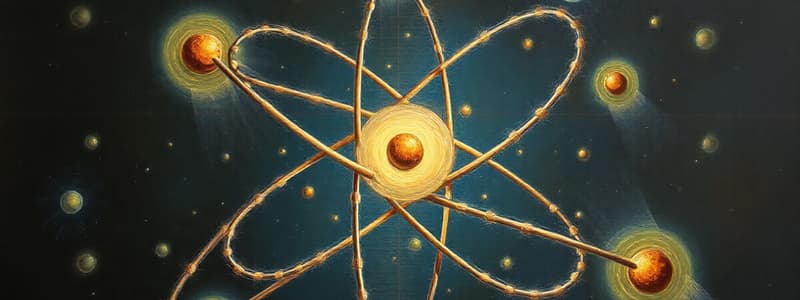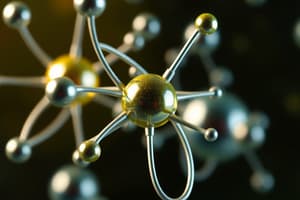Podcast
Questions and Answers
Democritus proposed that matter is made up of indivisible particles called '______'.
Democritus proposed that matter is made up of indivisible particles called '______'.
atomos
J.J. Thomson developed the '______ pudding model' of the atom.
J.J. Thomson developed the '______ pudding model' of the atom.
plum
J.J. Thomson's work led to the discovery of the '______'.
J.J. Thomson's work led to the discovery of the '______'.
electron
Ernest Rutherford discovered the '______' through his gold foil experiment.
Ernest Rutherford discovered the '______' through his gold foil experiment.
The Nuclear Model of the Atom indicates that the atom is mostly '______'.
The Nuclear Model of the Atom indicates that the atom is mostly '______'.
The Bohr Model describes electrons orbiting the nucleus in specific '______'.
The Bohr Model describes electrons orbiting the nucleus in specific '______'.
James Chadwick discovered the '______', a subatomic particle with no electric charge.
James Chadwick discovered the '______', a subatomic particle with no electric charge.
The modern quantum mechanical model of the atom was developed by '______'.
The modern quantum mechanical model of the atom was developed by '______'.
Flashcards
Democritus's Atomos
Democritus's Atomos
The idea that matter is made up of indivisible particles called 'atomos'. This was a foundational concept in ancient Greek philosophy.
Plum Pudding Model
Plum Pudding Model
A model of the atom proposed by J.J. Thomson depicting a sphere of positive charge with negatively charged electrons embedded throughout, like raisins in a pudding.
Discovery of the Electron
Discovery of the Electron
The discovery of the negatively charged particles within atoms, named electrons, through Thomson's cathode ray tube experiment in 1897.
Discovery of the Nucleus
Discovery of the Nucleus
Signup and view all the flashcards
Rutherford's Nuclear Model
Rutherford's Nuclear Model
Signup and view all the flashcards
Bohr's Model
Bohr's Model
Signup and view all the flashcards
Neutron
Neutron
Signup and view all the flashcards
Quantum Mechanical Model
Quantum Mechanical Model
Signup and view all the flashcards
Study Notes
Early Atomic Models
- Democritus proposed the "atomos," indivisible particles, as the fundamental building blocks of matter.
- J.J. Thomson's plum pudding model depicted the atom as a sphere of positive charge with negatively charged electrons embedded within.
- Thomson's cathode ray tube experiment discovered the electron as a negatively charged particle.
Rutherford's Nuclear Model
- Rutherford's gold foil experiment revealed a small, dense, positively charged nucleus at the atom's center.
- The nuclear model illustrates that most of the atom is empty space, with the nucleus containing nearly all the mass.
- The nucleus is positively charged, while electrons orbit the nucleus at significant distances.
Bohr Model
- The Bohr model postulates that electrons orbit the nucleus in specific energy levels.
- Electrons in this model do not continuously emit radiation; instead, energy is exchanged in discrete jumps between energy levels.
Chadwick's Neutron
- James Chadwick discovered the neutron in 1932.
- Neutrons are electrically neutral and have a mass similar to protons.
Quantum Mechanical Model
- The quantum mechanical model, developed by Schrödinger, Heisenberg, and Born, describes electrons as wave-like particles.
- This model predicts the probability of finding an electron in a specific region around the nucleus, instead of fixed orbits.
Studying That Suits You
Use AI to generate personalized quizzes and flashcards to suit your learning preferences.




